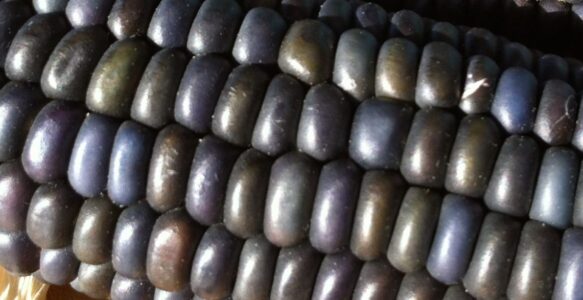|By Steven Martyn|
Before I plant, I sit for a while to listen and talk to Her, the seeds and the land, where they will be planted. As I roll the black-blue, pearl-like seeds around in my hand like a rosary,  singing my story and prayers into the ancient ones, She of a thousand faces appears to accept my prayers. She’s dancing as a tiger butterfly over the planting area, beautiful, light, magical. As I plant the blue jewels, little transparent worlds with layers of green and purple, I sing a new song that the butterfly teaches me.
singing my story and prayers into the ancient ones, She of a thousand faces appears to accept my prayers. She’s dancing as a tiger butterfly over the planting area, beautiful, light, magical. As I plant the blue jewels, little transparent worlds with layers of green and purple, I sing a new song that the butterfly teaches me.
The blessing deepens. After I plant I sit and journey with the Hopi warriors I have just sown. At the end of my ceremony I open my eyes and notice, over the first seed I planted in the first row, there is a bristling of black and yellow fire. There’s a hundred or more Swallowtails. One for each seed, all dancing together on the shining wet ground.
I plant these Hopi blue corn in staggered years, so as to not cross her with other long seasoned ‘grain’ corn. She came to me through my dear friends Stephen and Nathalie, to them from Martin Pretchel, and to him from the Hopi who’ve kept them for thousands of years. I am so thankful She found her way to me to grow, bloom and fruit here, thousands of miles north of her ancestral home. Through keeping and growing her, I feel the countless other growers who have worked with her. They have all worked as sacred priests, protecting and nurturing her, to bring her to my hand and land on this very day I offer her back to the Earth.
To eat her, we first strip the dried cobs by hand. The first few kernels are hard to budge, but once the mother corn knows you’re serious, She gives the rest more easily. We soak our grain corn in a pre-made mixture of wood ash and water, or limestone powder and water. This process is called nixtamalization. This process greatly increases the availability of nutrients to us from the corn. According to Sandor Katz in his book ‘Wild Fermentation‘, “..it alters the ratio of available amino acids, rendering nixtamalized corn a complete protein, and making niacin in the corn more available to humans”. When it’s not done this way, as it isn’t in all North American forms of corn, then your body not only doesn’t receive the corn’s nutrition, but the corn can cause deficiencies, digestion problems and inflammation.
Unprocessed corn is the basis of our food. It’s in literally thousands of products in the supermarket and forms the core of industrial animal feed for chickens, pigs and cows, both meat and dairy. What’s really scary is that the corn not only isn’t nixtamalized, it’s also most likely GMO. Yikes. It’s no wonder that so many people can’t eat food from the supermarket anymore.

Good locally adapted heritage corn is hard to come by for the consumer, and the growers, for many reasons. First, corn takes a lot from the land, and considering this when it’s being sold, even ‘by the dozen’, it doesn’t pay. The input costs of good land, seed, fertilizing and weeding aren’t covered. And because so very few organic growers can be bothered growing and saving heritage corn, there are very few regionally adapted types of heritage corn being grown. If organic corn was thirty dollars a dozen, that’s about the minimum it’s actually worth. To make it even trickier, corn cross-pollinates by wind very easily and at a great distance. So, even if you have an open-pollinated heritage strain, you must grow many miles away from the nearest GMO or other hybrid types as they will cross with the treasured seed.
The seed companies and government has thousands of heritage corn strains stashed away in the deep freeze but this may or may not ever trickle down to the small farmer. Unfortunately, it’s more likely that this seeds will be used by multinationals as “raw materials” to create “new better strains”. Meanwhile if the government was actually interested in helping people of the future, they’d support the small farmers of the day that are helping keep these seeds alive. Helping the seeds be who they are, and helping them adapt, year by year to a changing world.
It has been just over a month since I sowed the corn and started this post. Every kernel germinated and they’re up and running, almost a foot tall. The beans that I plant around the corn, (Northeastern Giant Climbing pole bean and Five nations beans) are running ahead, some are three feet long.
Here’s our favourite cornbread recipe, from Sally Fallon‘s Nourishing Traditions. This cornbread is delicious, and sticks with you. You can feel how much more nutritive it is that a standard cornbread recipe.
Enjoy!
CORNBREAD
serves 6-8
2 cups freshly ground cornmeal
1/2 cup freshly ground spelt, kamut or whole wheat flour
1/2 cup unbleached white flour
1 1/2 cups lime water ( 1 inch pickling lime soaked in a 2 quart jar, shake well and leave overnight).
1 cup buttermilk or yogurt
3 eggs, lightly beaten
1/4 cup maple syrup
1 tsp sea salt
2 tsps baking soda
1/4 cup melted butter
Soak cornmeal in lime water for about 7 hours. Stir in flour and buttermilk (or yogurt) and let stand for 12 to 24 hours. Blend in remaining ingredients. Pour into a buttered 9×13 pan. Bake at 325 for about 1 hour, or until a toothpick comes out clean.
Let us know how it goes!


